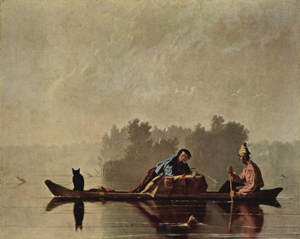
Williams grew up in Columbia and studied art history at the University of Missouri. “The two art forms that really please me are paintings and—this sounds funny—the art of small business,” she said. “I love being downtown, where there are all these single-owner small businesses.” Her establishment is part of that group of healthy small-market endeavors around downtown. But the wealth of history begging to be unearthed in her search for high-quality fine art, she said, also has been a draw to stay in Mid-Missouri over the years.
Mary Pixley, associate curator at MU’s Museum of Art and Archaeology, respects Williams immensely, she said in an email. “Gallery owners of Melissa’s quality rarely choose to set up shop in out-of-the-way places like Columbia. The fact that she shares her expertise with Columbia, Missouri, is a statement about how much she cares about art and the city of Columbia.”
Williams’ gallery is open Fridays. Her relentless pursuit of art leads her around–and at times outside—the community. “We have to get out and buy each object individually,” she said. “People like to ask us, ‘Where do you find your things?’ as though there’s a store. We just have to say, ‘No, you could find them, too.’” It is simply a matter of a dogged tracking-down of particular works and artists, she added.
She not only sells art to Missourians but also on the coasts; this summer, for example, she sold art in Newport, R.I., to which collectors from Nantucket often travel. “The Midwest—with with certain pockets—is still the least expensive place to buy antiques,” she said. “There’s really much more interest everywhere in the country about regional things … I think as we get more international, everybody is looking for the roots of the places they live in.”
Several books have been written about the material culture of states such as California, Pennsylvania and Texas, Williams said, but no prominent books have been written about how to collect artifacts and art from Missouri. That keeps the prices low. “I think Missourians” might be tempted to buy into “the East Coast view of our cultural heritage, that there really isn’t anything to our cultural history,” she said. “Which is so totally wrong.”
An art dealer at a coastal show once asked her to name one Missouri-based work of art that is an American icon. She immediately rattled off Fur Traders Descending the Missouri, an 1845 painting by the renowned George Caleb Bingham, now possessed by the Metropolitan Museum of Art. “He looked at me, and he just said, ‘You can’t count that,’” she remembered.
But Williams is expectant that as Missourians and out-of-state visitors continue to discover the unparalleled art inside the Capitol at Jefferson City, and rediscover historically renowned artists from St. Louis and the colony of Ste. Genevieve, appropriate appreciation for Missouri art and its material culture will flourish.
At the core of Williams’ passion lies an impulse to find art by Midwesterners who once were well-known but have been forgotten by today’s art world. She consistently looks for art by those who painted massive lunettes inside the Capitol, including the likes of Thomas Barnett and Frank Nuderscher. In the 19th and 20th centuries, she explained, artists would work with a dealer, who would often have a large body of work to represent. After artists passed away, dealers stopped representing them, “and so, a great painter becomes forgotten,” Williams said. Afterward, there is “this gap where nobody is paying any attention—and then it comes back.”
“I sell to a lot of people who couldn’t care less about how old it is, but they want something that is very different,” she added. “They haven’t seen anything like this before, and so they’ll search in the past. They’re just fascinated by the innovation that the artist brought.”
Williams sells to many collectors who initially buy a painting for its aesthetic and later become enticed by its history. “I think people will sometimes buy a painting from me as decoration. And then two or three years later, they’ll call me and say, ‘I lost that biography. Tell me about this artist because I keep wondering: Who is this artist whose painting I look at every day?’
“It’s a learning of not just what you like but what you’re fascinated by that can be a portal to you to all sorts of discovery within yourself or learning about the artist or learning about the era that it was painted in,” she said. “There’s so much more than just the word ‘like.’”
___
Information from: Columbia Daily Tribune, http://www.columbiatribune.com
Copyright 2011 Associated Press. All rights reserved. This material may not be published, broadcast, rewritten, or redistributed.
AP-WF-09-23-11 1430GMT


